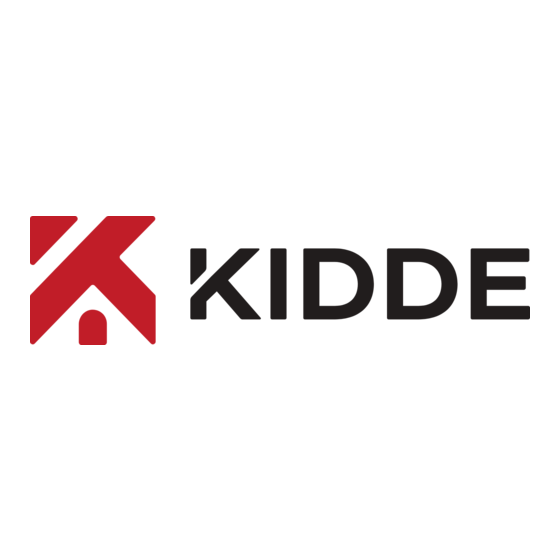Table of Contents
Advertisement
0916LL
Smoke Alarm User's Guide
9 Volt Battery Operated Smoke Alarm with "HUSH"
Control to temporarily silence nuisance alarms.
Thank you for purchasing this smoke alarm. It is an important
part of your family's home safety plan. You can trust this prod-
uct to provide the highest quality safety protection. We know
you expect nothing less when the lives of your family are at
stake.
For your convenience, write down the following
information. If you call our Consumer Hotline,
these are the first questions you will be asked.
Smoke Alarm Model Number
(located on back of alarm):
Date Code (located on back of alarm):
The National Fire Protection Association
(NFPA) and the manufacturer
recommend replacing this alarm
ten years from the date code.
Date of Purchase:
Where Purchased:
For model: 0916LL
820-0899 REV. B
11/2006
Advertisement
Table of Contents

Summary of Contents for Kidde 0916LL
- Page 1 For model: 0916LL 0916LL Smoke Alarm User’s Guide 9 Volt Battery Operated Smoke Alarm with “HUSH” Control to temporarily silence nuisance alarms. Thank you for purchasing this smoke alarm. It is an important part of your family’s home safety plan. You can trust this prod- uct to provide the highest quality safety protection.
-
Page 2: Recommended Locations For Alarms
This alarm detects products of combustion using the ionization technique. It contains 0.9 microcurie of Americium 241, a radioac- tive material (see Section 9). Distributed under U.S. NRC License No. 32-23858-01E. Manufactured in compliance with U.S. NRC safety criteria in 10 CFR 32.27. The purchaser is exempt from any regulatory requirements. - Page 3 • Locate an alarm in every room where electrical appliances are operated (i.e. portable heaters or humidifiers). • Locate an alarm in every room where someone sleeps with the door closed. The closed door may prevent an alarm not locat- ed in that room from waking the sleeper.
-
Page 4: Mobile Home Installation
• Put smoke alarms at both ends of a bedroom hallway or large room if the hallway or room is more than 30 ft (9.1 m) long. • Install Smoke Alarms on sloped, peaked or cathedral ceilings at or within 3 ft (0.9m) of the highest point (measured horizontal- ly). -
Page 5: Installation Instructions
• In very humid areas. Moisture or steam can cause nuisance alarms. • In insect-infested areas. • Smoke alarms should not be installed within 3 ft (.9m) of the fol- lowing: the door to a kitchen, the door to a bathroom containing a tub or shower, forced air supply ducts used for heating or cool- ing, ceiling or whole house ventilating fans, or other high air flow areas. - Page 6 1. Remove the mounting plate from the back of the alarm by holding the mounting plate and twisting the alarm in the direc- tion indicated by the “OFF” arrow on the alarm cover. 2. To insure aesthetic alignment of the alarm with the hallway or wall, the “A”...
-
Page 7: Operation And Testing
NOTE: THE TAMPER RESIST PIN WILL HAVE TO BE REMOVED IN ORDER TO CHANGE THE BATTERIES. USE LONG NOSE PLI- ERS TO PULL THE PIN OUT OF THE HOLE. IT IS NOW POSSI- BLE TO REMOVE THE ALARM FROM THE MOUNTING PLATE. 8. -
Page 8: Nuisance Alarms
alarm or ignite combustible materials and start a structure fire. TEST THE ALARM WEEKLY TO ENSURE PROPER OPERATION. Erratic or low sound coming from your alarm may indicate a defective alarm, and it should be returned for service (see section 12). NOTE: WEEKLY TESTING IS REQUIRED. -
Page 9: Limitations Of Smoke Alarms
Carbon-zinc type EVEREADY 216 OR 1222; GOLD PEAK 1604P OR 1604S Alkaline type ENERGIZER 522; DURACELL MN1604, MX1604; GOLD PEAK 1604A; PANASONIC 6AM6, 6AM-6, 6AM-6PI, 6AM6X, AND 6LR61 (GA) Lithium type ULTRALIFE U9VL-J NOTE: WEEKLY TESTING IS REQUIRED. WARNING!! USE ONLY THE BATTERIES SPECIFIED. USE OF DIFFERENT BATTERIES MAY HAVE A DETRIMENTAL EFFECT ON THE SMOKE ALARM. - Page 10 (associated with slow smoldering fires) sooner than ioniza- tion alarms. Home fires develop in different ways and are often unpredictable. For maximum protection, Kidde recommends that both Ionization and Photoelectric alarms be installed. • A battery powered alarm must have a battery of the specified type, in good condition and installed properly.
-
Page 11: What To Do When The Alarm Sounds
• Practice a fire drill at least every six months, including fire drills at night. Ensure that small children hear the alarm and wake when it sounds. They must wake up in order to execute the escape plan. Practice allows all occupants to test your plan before an emergency. -
Page 12: Nrc Information
9. NRC INFORMATION Ionization type smoke alarms use a very small amount of a radioactive element in the sensing chamber to enable detection of visible and invisible combustion products. The radioactive element is safely contained in the chamber and requires no adjustments or maintenance. -
Page 13: Service And Warranty
If after reviewing this manual you feel that your smoke alarm is defective in any way, do not tamper with the unit. Return it for servicing to: KIDDE Safety, 1016 Corporate Park Dr., Mebane, NC 27302. 800-880-6788 (See Warranty for in-warranty returns). -
Page 14: Five Year Limited Warranty
(but not the battery) will be free from defects in material and workmanship or design under normal use and service for a period of ten years from the date of purchase. The obligation of KIDDE Safety under this warranty is limited to repairing or replacing the smoke alarm... - Page 15 The obligation of KIDDE Safety & Ultralife Batteries Inc. under this war- ranty is limited to repairing or replacing the smoke alarm or battery, or any part which we find to be defective in material, workmanship or design, free of charge to the customer.








Need help?
Do you have a question about the 0916LL and is the answer not in the manual?
Questions and answers